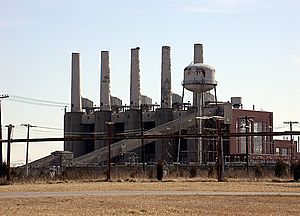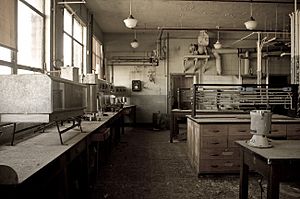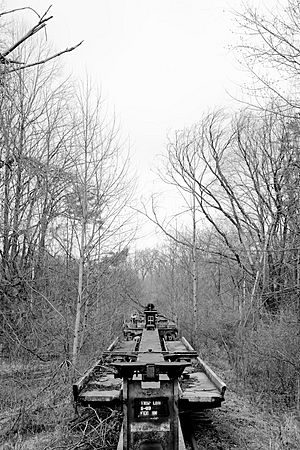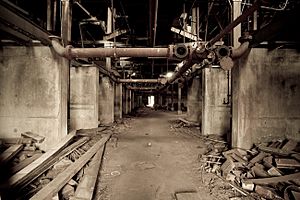Indiana Army Ammunition Plant facts for kids
The Indiana Army Ammunition Plant was a huge factory built by the U.S. Army in 1941. It was located in Indiana, between the towns of Charlestown and Jeffersonville, Indiana. This plant was made up of three main parts, all working together to create important materials for the military:
- Indiana Ordnance Works Plant 1 (IOW#1): This part made smokeless powder, a special type of gunpowder.
- Indiana Ordnance Works Plant 2 (IOW#2): This section produced rocket propellant, which is the fuel that makes rockets fly.
- Hoosier Ordnance Plant (HOP): This area created and packed propellant charge bags, which are used to fire artillery shells.
Contents
Building the Plant
In 1940, the U.S. government decided to build the world's largest smokeless powder plant near Charlestown. This location was chosen for a few good reasons. It was close to the Ohio River, which provided the large amount of water needed to make smokeless powder. Also, the land was inexpensive because it wasn't great for farming, and not many people lived there.
The plant was built and run as a "Government-Owned, Contractor-Operated" (GOCO) facility. This means the government owned the factory, but private companies were hired to build and operate it.
Plant 1: Smokeless Powder
Building for Indiana Ordnance Works Plant 1 started in September 1940. It was finished by May 1942. The first part of the plant began making smokeless powder in April 1941. E.I. DuPont de Nemours and Co. built and first operated this section.
During World War II, this plant made more smokeless powder than all other U.S. plants had made during World War I combined! After the war, production stopped. But during the Korean War, DuPont cleaned up the plant and started making powder again in 1950. It ran at full speed with 3,000 employees until 1954.
Plant 2: Rocket Propellant
Indiana Ordnance Works Plant 2 was designed to make rocket propellant. Construction began in November 1944. However, it stopped before it was finished on V-J Day (Victory over Japan Day), which marked the end of World War II.
Most of this plant was then put into "caretaker status," meaning it was kept safe but not used. In 1960, all the stored powder was removed. A large part of the land (about 1,546 acres) was given to the government for other uses. The rest of the land was used for woodlands, crops, and later, a new black powder factory.
Hoosier Ordnance Plant: Propellant Bags
The Hoosier Ordnance Plant was built by a company called W-H-M-S Construction. Goodyear Engineering Corporation (GEC) operated it. This plant started making propellant charge bags in September 1941 and continued until V-J Day in 1945.
Limited production started again in 1950. Goodyear took full control in July 1952. During the Korean War, in August 1953, this plant had its highest number of workers, with 8,067 people employed.
Impact on the Area
By May 1941, the three plants together employed 27,520 people. This was a huge help for the local area. It provided many jobs and helped the community recover from the hard times of the Great Depression.
After the Wars
On November 30, 1945, the three separate plants were combined into one big facility called the Indiana Arsenal. In August 1963, its name was changed to the Indiana Army Ammunition Plant.
In March 1959, Goodyear took over maintaining all the plants. Other companies, like Liberty Powder Defense Corporation and Olin Mathieson Chemical Corporation, later took over operations. By April 1972, ICI Americas was in charge.
After Plant 2 was no longer part of the facility, the remaining plant still covered about 10,655 acres. It had 1,700 buildings, 30 miles of fence, 84 miles of railroad tracks, and 190 miles of roads!
In June 1960, about 67 acres of Plant 1 were given to Clark County. This land is now used as the site for the 4-H Center, a place for youth development programs.
What's There Now?
The ammunition factory stopped most of its operations in 1992. ICI Americas then managed it as an industrial park. Congress later approved the transfer of the land to a local group called the INAAP Reuse Authority.
Today, this area is known as the River Ridge Commerce Center. About 3,000 acres of the land were transferred in October 2007. Another 3,000 acres from Plant 1 are waiting to be cleaned up before they can be transferred.
The remaining 4,500 acres were given to the State of Indiana. This land is now part of Charlestown State Park, a beautiful park managed by the Indiana Department of Natural Resources.
An environmental company, E W Wells Group, has been working to remove explosive leftover materials and tear down old buildings. The final cleanup of the plant was planned to be finished by the end of 2014.





